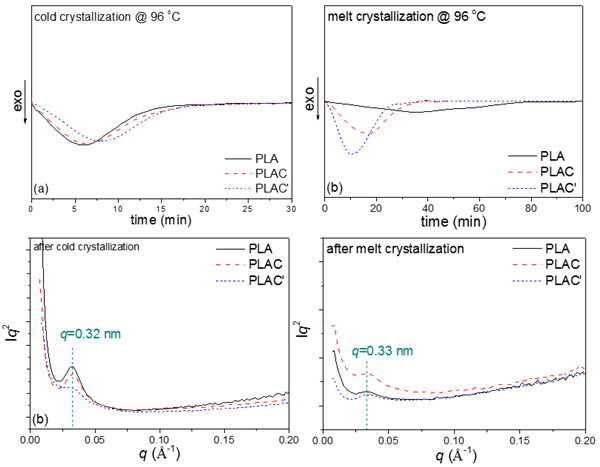Polylactide/Cellulose Nanocrystal Composites: A Comparative Study on Cold and Melt Crystallization
作者:Chunjiang Xu, Qiaolian Lv, Defeng Wu, Zhifeng Wang
关键字:cellulose nanocrystal; polylactide; composites; crystallization; nucleation.
论文来源:期刊
具体来源:Cellulose
发表时间:2017年
Cellulose, 2017, 24(5), 2163-2175.

ABSTRACT:
Polylactide (PLA) composites with pristine cellulose nanocrystals
(CNC) and acetylated one (aCNC) were prepared for the crystallization study. The roles
of CNC and aCNC in cold and melt
crystallization of PLA were explored. Both CNC and aCNC have good nucleation activity during
cold crystallization of PLA, but also highly impede transport
of adjacent chain segments to the growing surface, acting as the role of
physical barrier in the glassy bulk. Within
the experimental temperature range, growth dominates the overall kinetics, rather
than nucleation. Therefore, barrier role overwhelms nucleation agent one and as a result, the cold crystallization rates of composites decrease as
compared with neat PLA, accompanied by decreased degrees of crystallinity. During melt crystallization, although the
presence of CNC and aCNC
leads to sharply increased system viscosities, reducing chain mobility,
nucleation is the dominant role as the systems crystallize from the melts.
Thus, the presence of CNC and aCNC
promotes melt crystallization of PLA, and the composites show far higher
crystallization rates and degrees of crystallinity than neat PLA. Besides, the surface acetylation
of CNC improves its nucleation ability during melt crystallization of PLA, and
as a result, the composite with aCNC
has denser fold surfaces relative to the one with CNC. But the presence of
these two kinds of particles has no evident influence on the lamellar structure
of PLA whether in the cold or in melt crystallization. This work can provide useful information on the
crystallization control of PLA using CNC.
PDF DOWNLOAD:
http://link.springer.com/article/10.1007/s10570-017-1233-x